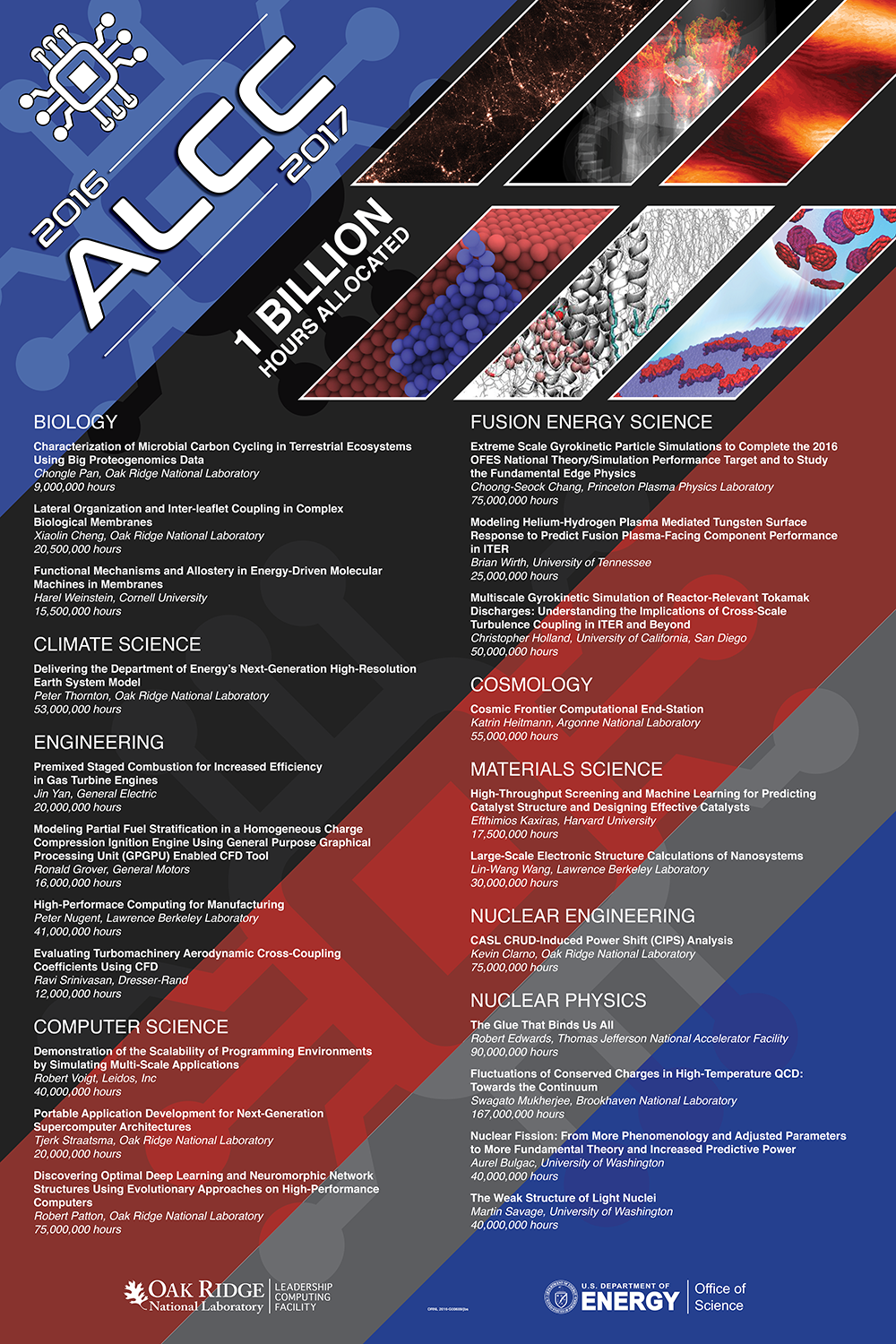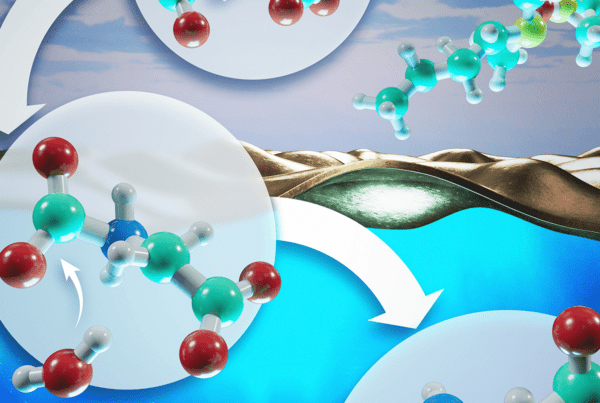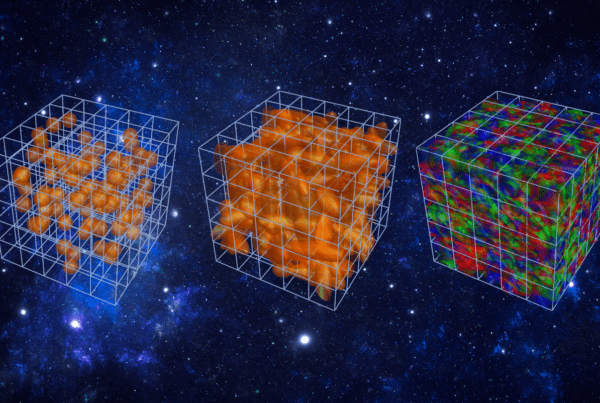
ALCC’s mission is to provide high-performance computing resources to projects that align with DOE’s broad energy mission, with an emphasis on high-risk, high-return simulations.
The US Department of Energy (DOE) Office of Science has awarded nearly 1 billion processor hours to 22 projects at the Oak Ridge Leadership Computing Facility (OLCF)— a DOE Office of Science User Facility located at DOE’s Oak Ridge National Laboratory—through the DOE Office of Advanced Scientific Computing Research Leadership Computing Challenge (ALCC).
ALCC’s mission is to provide high-performance computing resources to projects that align with DOE’s broad energy mission, with an emphasis on high-risk, high-return simulations. The ALCC program allocates up to 30 percent of the computational resources at the OLCF and the Argonne Leadership Computing Facility, as well as up to 10 percent at the National Energy Research Scientific Computing Center.
“In addition to supporting the DOE mission, the program also seeks to broaden the field of researchers able to use some of the world’s fastest and most powerful supercomputers like Titan at the OLCF,” said Jack Wells, OLCF director of science.
The ALCC grants 1-year awards and supports scientists from industry, academia, and national laboratories who are advancing scientific and technological research in energy-related fields. Past ALCC allocations contributed to scientific discovery in energy efficiency, computer science, climate modeling, materials science, bioenergy, and basic research.
The 2016 projects will continue that reputation of discovery with topics that range from the biology of neurotransmitters to the search for affordable catalysts to the development of future clean energy technology. Scientific domains represented among the awards include biology, climate science, engineering, computer science, nuclear fusion, cosmology, materials science, nuclear engineering, and nuclear physics. Awards on Titan—ranging from 9 million to 167 million processor hours—went to projects that include the following:
Materials Science. Catalysis plays a critical role both in the current energy landscape and by potentially enabling future clean energy technologies. A catalyst facilitates a chemical reaction and increases the reaction rate, but the substance isn’t consumed in the reaction and is, therefore, available to ease subsequent reactions. Breakthroughs in catalyst design paradigms could significantly increase energy efficiency. The search for effective and affordable catalysts is critical in both chemistry and materials science, as well as in large-scale industrial concerns.
The computing resources on Titan will allow a team led by Efthimios Kaxiras from Harvard University to use high-throughput computation to generate datasets that will augment scientists’ abilities to predict useful catalysts. The team will focus on using nanoporous gold, which is an active, stable, and highly selective catalyst, in a particular reaction—anhydrous dehydrogenation of methanol to formaldehyde (a common chemical with multiple industrial uses).
Catalysts traditionally have been developed using experimental trial and error or by testing known catalysts for similar reactions. The primary obstacles to designing new novel catalysts are twofold: the complexity of catalytic materials and the wide range of possible catalytic materials.
The team is searching for an alloy catalyst that can produce formaldehyde from methanol without producing water, which involves energy-intensive separation steps. Because it is impossible to experimentally synthesize and test tens of thousands of possible bimetallic catalysts, the researchers will use Titan to computationally perform the screening.
Biology. A team led by Cornell University’s Harel Weinstein seeks to determine the functional properties and energy-conserving mechanisms of cellular membrane proteins called neurotransmitter transporters. Specifically, the team hopes to uncover the biological machinery of neurotransmitter sodium symporters, a family of neurotransmitter transporters responsible for the release and reuptake of chemical signals between neurons.
A major focus of the team is the dopamine transporter (DAT), the gatekeeper for the neurotransmitter dopamine that is associated with reward-motivated behavior. By simulating DAT, Weinstein and his collaborators hope not only to learn how cells harness energy to move molecules against a concentration gradient but also to uncover potential strategies for treating DAT-related disorders such as addiction and depression.
Using molecular dynamics and high-performance computing, the team will be able to gain a clearer picture of how the transporter works at the molecular level—how energy is gained, stored, and used. Additionally, simulation of updated models could shed light on DAT mutations related to diseases such as autism, Parkinson’s disease, and attention deficit hyperactivity disorder, which have been shown to be affected by malfunctions of the neurotransmission process.
Nuclear Physics. The accurate description of nuclear fission is relevant to a number of fields, including basic energy, nuclear waste disposal, national security, and nuclear forensics. The current theoretical description is based on limited models that rely on mathematical shortcuts and constraints and on a large collection of experimental data accumulated since 1939.
Because many aspects of nuclear fission cannot be probed in the laboratory, devising a microscopic theory based on the fundamental properties of nuclear forces is a highly desirable goal. A team led by the University of Washington’s Aurel Bulgac will use Titan to study the sensitivity of fission fragment properties and fission dynamics using a novel theoretical approach that extends the widely used density functional theory (DFT) to superfluid nuclei. In particular, the team will focus on fission fragment excitation energies and total kinetic energy, which are difficult to extract using phenomenological models.
In previous work involving Titan, the team developed a real-time DFT extension that explicitly includes the full dynamics of the crucial pairing correlations. Applying the method to a fissioning plutonium-240 nucleus, the team determined the final stages of fission last about 10 times longer than previously calculated. The code is one of the first in nuclear theory to take full advantage of GPU accelerators.
Engineering. The High Performance Computing for Manufacturing (HPC4Mfg) program pairs US manufacturers with national labs’ world-class computing experts and advanced computing resources to address key challenges in US manufacturing. The solutions resulting from this collaboration will have broad industry and national impact.
Three companies—Global Foundries, General Electric, and United Technologies Research Center—will use Titan as part of the HPC4Mfg program seeking to deliver solutions that can revolutionize the manufacturing industry through energy efficiency and increased innovation.
Oak Ridge National Laboratory is supported by the US Department of Energy’s Office of Science. The single largest supporter of basic research in the physical sciences in the United States, the Office of Science is working to address some of the most pressing challenges of our time. For more information, please visit science.energy.gov.






